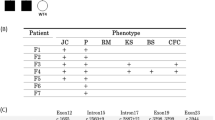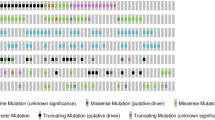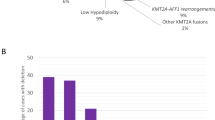Abstract
Individuals with naevoid basal cell carcinoma (Gorlin) syndrome are at increased risk of developing medulloblastoma in childhood. We have shown that approximately 5% of patients with Gorlin syndrome will develop this complication in the first few years of life, and in addition 10% of patients with medulloblastoma diagnosed at age 2 years or under have Gorlin syndrome. One out of three medulloblastomas occurring in patients with Gorlin syndrome was shown to have lost the wild-type allele on 9q, indicating that the Gorlin locus probably acts as a tumour suppressor in the development of this tumour. We have also confirmed this role in a basal cell carcinoma (BCC) from the same individual. Information from these families would suggest that Gorlin syndrome is more common than previously recognized and may not always be diagnosed on clinical grounds alone even in middle life.
This is a preview of subscription content, access via your institution
Access options
Subscribe to this journal
Receive 24 print issues and online access
$259.00 per year
only $10.79 per issue
Buy this article
- Purchase on Springer Link
- Instant access to full article PDF
Prices may be subject to local taxes which are calculated during checkout
Similar content being viewed by others
Author information
Authors and Affiliations
Rights and permissions
About this article
Cite this article
Cowan, R., Hoban, P., Kelsey, A. et al. The gene for the naevoid basal cell carcinoma syndrome acts as a tumour-suppressor gene in medulloblastoma. Br J Cancer 76, 141–145 (1997). https://doi.org/10.1038/bjc.1997.354
Issue Date:
DOI: https://doi.org/10.1038/bjc.1997.354
This article is cited by
-
Current recommendations for cancer surveillance in Gorlin syndrome: a report from the SIOPE host genome working group (SIOPE HGWG)
Familial Cancer (2021)
-
Intracardiac tumor as a rare manifestation of genetic syndromes—presentation of a family with Gorlin syndrome and a literature review
Journal of Applied Genetics (2020)
-
Inhibition of sonic hedgehog and PI3K/Akt/mTOR pathways cooperate in suppressing survival, self-renewal and tumorigenic potential of glioblastoma-initiating cells
Molecular and Cellular Biochemistry (2019)
-
Seltene Tumordispositionssyndrome mit Manifestation im Kindesalter
Medizinische Genetik (2017)



